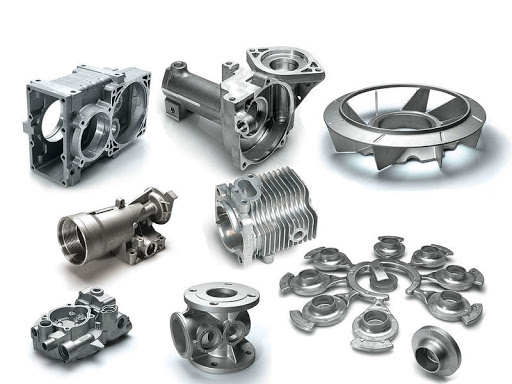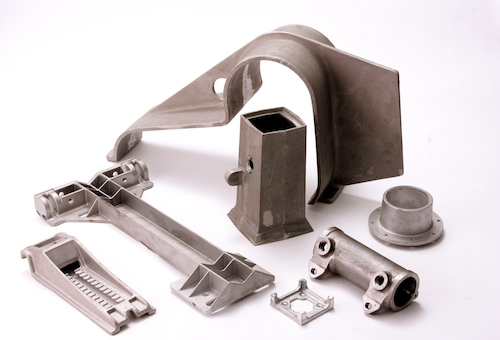How Aluminum Foundry processes create reliable components
Discovering the Versatile Utilizes and Applications of Aluminum Castings in Modern Industries
Light weight aluminum castings have actually become integral to various modern-day markets due to their special buildings. They supply significant advantages in weight reduction, thermal conductivity, and deterioration resistance. From automobile advancements to applications in customer goods and construction, their adaptability is impressive. The true degree of their effect prolongs beyond instant advantages, hinting at wider implications for sustainability and effectiveness. What lies in advance for light weight aluminum spreadings in an ever-evolving industrial landscape?
Automotive Industry Innovations
The auto sector has increasingly welcomed light weight aluminum spreadings to enhance vehicle efficiency and effectiveness. By utilizing light weight aluminum, producers can generate lighter components, which add to boosted gas economic climate and reduced exhausts. Key applications consist of engine blocks, transmission situations, and structural components, where the material's strength-to-weight proportion delivers toughness without adding excess weight.
Aluminum castings additionally use superior thermal conductivity, which assists in better warm dissipation, therefore boosting engine efficiency. Moreover, improvements in casting innovations, such as die spreading and sand spreading, allow the manufacturing of complex geometries, allowing for cutting-edge styles that optimize room and capability.
The recyclability of aluminum straightens with sustainability goals in the vehicle field, promoting eco-friendly methods. As the market proceeds to introduce, making use of aluminum castings is most likely to increase, driving more developments in automobile design and effectiveness.
Aerospace Applications and Innovations
While the aerospace industry remains to prioritize weight reduction and gas effectiveness, light weight aluminum spreadings have actually arised as a crucial material option for numerous applications. Their lightweight nature, coupled with high strength-to-weight ratios, permits significant improvements in aircraft performance and effectiveness. Aluminum castings are typically used in structural components, such as fuselage frames and wing parts, where decreasing weight is vital.
Current improvements in light weight aluminum casting innovations, consisting of enhanced alloy formulations and accuracy spreading strategies, have further boosted the product's performance capacities. These advancements enable the production of intricate geometries and elaborate designs while keeping structural stability. Furthermore, light weight aluminum's superb rust resistance guarantees long life and dependability in harsh aerospace atmospheres.
As the aerospace sector significantly embraces sustainability, light weight aluminum castings offer a recyclable option that straightens with green techniques, making them an essential component in the development of next-generation aircraft.
Customer Goods and Everyday Products
As consumers increasingly seek light-weight yet durable materials for everyday items, light weight aluminum castings have acquired appeal in different durable goods. The distinct residential or commercial properties of light weight aluminum, including its resistance to deterioration and exceptional thermal conductivity, make it an ideal option for things like cookware, family devices, and outdoor gear. For example, aluminum cast pots and pans give also warm circulation, enhancing cooking efficiency. Additionally, the usage of light weight aluminum in items such as bicycle frameworks and travel luggage guarantees a balance between strength and portability. Manufacturers value light weight aluminum spreadings for their adaptability, as they can be quickly molded right into intricate shapes while keeping structural stability. The capability to recycle light weight aluminum without deteriorating its homes lines up with expanding consumer preferences for lasting products. Generally, light weight aluminum castings are important to the production of sturdy, practical, and cosmetically pleasing consumer items, fulfilling the demands of modern-day lifestyles.
Building and Architectural Uses
Aluminum castings have come to be a crucial element in building and construction and architectural design, particularly due to their strength and lightweight nature. These residential properties make light weight aluminum an excellent choice for numerous applications, including architectural components, facades, and decorative features - Metal Castings. Home builders and engineers increasingly make use of light weight aluminum spreadings for window frameworks, doors, and roof, enhancing both capability and aesthetics. The product's resistance to corrosion additionally expands its life expectancy, lowering maintenance costs and ensuring longevity in diverse ecological conditions
Additionally, aluminum can be quickly molded into detailed styles, enabling innovative architectural expressions. Its versatility assists in the production of custom items that fulfill specific design demands, from luxuriant barriers to complicated supports. As sustainability comes to be a concern, aluminum's recyclability includes in its appeal in green construction methods. Generally, aluminum castings are transforming the construction market by supplying lightweight, durable, and aesthetically attractive services.
Electrical and Digital Parts
Light weight aluminum spreadings play a necessary function in the manufacturing of light-weight electric rooms, which improve transportability and performance in various applications. Additionally, their superb thermal conductivity makes them excellent for warmth sinks, making certain peak efficiency and long life of electronic elements. Light weight aluminum's conductive residential or commercial properties add to its use in various electrical conductors, stressing its value in contemporary innovation.
Lightweight Electrical Rooms
Lightweight electrical enclosures play a vital duty in protecting sensitive electronic elements from ecological aspects and physical damage. Created from aluminum spreadings, these enclosures are valued for their strength-to-weight ratio, making them optimal for numerous applications throughout industries. Their lightweight nature aids in lowering general system weight, which is vital in mobile and mobile electronics. Furthermore, light weight aluminum's rust resistance boosts resilience, expanding the life-span of the enclosed elements. The capacity to mold and mildew light weight aluminum right into complex forms enables tailored styles, dealing with particular requirements while ensuring efficient warm dissipation. Furthermore, these enclosures can be quickly incorporated into existing systems, offering adaptability and adaptability in contemporary technological settings. Overall, lightweight aluminum units considerably add to the efficiency of electronic tools.
Warmth Sinks and Conductors
While several products are made use of in electronic elements, aluminum castings stand out for their efficiency in heat monitoring as heat sinks and conductors. Their superb thermal conductivity enables reliable heat dissipation, which is essential in preventing the getting too hot of electronic tools. Aluminum's light-weight nature further improves its suitability for applications where weight is a considerable element, such as in aerospace and vehicle industries. Furthermore, light weight aluminum spreadings can be quickly molded into intricate shapes, giving style versatility for optimizing thermal efficiency. The deterioration resistance of light weight aluminum additionally adds to the longevity and reliability of these components in various environments. As innovation read this post here advances and devices end up being much more compact, the demand for efficient heat monitoring services, like light weight aluminum castings, proceeds to expand.
Marine Sector Usage
The marine industry increasingly relies on aluminum castings for their extraordinary resilience and deterioration resistance. These homes make aluminum an excellent selection for various applications, including boat hulls, engine components, and aquatic equipment. The lightweight nature of aluminum castings allows boosted gas performance and much easier maneuverability in watercraft, which is crucial for both recreational and commercial vessels.

Aluminum castings also supply significant price benefits due to their long life-span and reduced upkeep needs, lowering the overall functional costs for aquatic operators. Furthermore, the flexibility of aluminum permits elaborate layouts that can meet certain efficiency demands.
Suppliers in the aquatic field use advanced spreading methods to generate complex shapes, guaranteeing that components meet extensive safety and performance requirements. As the demand for high-performance marine vessels expands, aluminum spreadings are positioned as a vital material in boosting the performance and durability of aquatic equipment.
Sustainability and Recycling in Light Weight Aluminum Casting

Light Weight Aluminum Recycling Refine
Reusing light weight aluminum plays a vital function in minimizing environmental influence and preserving resources within the spreading industry. The light weight aluminum recycling process begins with the collection of scrap aluminum, which her comment is here can consist of old parts, manufacturing waste, and post-consumer items. This scrap is after that arranged, cleaned, and shredded into tiny pieces to facilitate melting.
When prepared, the light weight aluminum scrap is melted in a heater at lower temperature levels than key light weight aluminum manufacturing, significantly reducing power intake. The liquified aluminum is then cast right into ingots or other forms for reuse in numerous applications - Metal Castings. This closed-loop system permits for the reliable healing of light weight aluminum, maintaining its homes while lowering the demand for virgin products. The recycling procedure is an important element of lasting methods in aluminum casting.
Environmental Benefits
While aluminum spreading plays a crucial duty in numerous sectors, its ecological advantages are especially exceptional relating to sustainability and resource conservation. The lightweight nature of light weight aluminum contributes to power efficiency in transport, minimizing fuel consumption and discharges. In addition, aluminum casting assists Continue in making use of recycled materials, significantly lowering the energy needed for manufacturing contrasted to main aluminum. This reusing process minimizes waste and minimizes the environmental impact connected with mining and refining raw materials. Aluminum is 100% recyclable without destruction of its properties, advertising a lasting lifecycle. By picking aluminum casting, markets can greatly minimize their carbon impact while promoting resource performance, making it an important choice in the search of eco-friendly manufacturing techniques.
Closed-Loop Equipments

Regularly Asked Questions
What Are the Secret Conveniences of Aluminum Castings Over Other Materials?
Light weight aluminum spreadings offer lightweight properties, exceptional deterioration resistance, and high strength-to-weight proportions. They can be easily molded into complicated forms, give excellent thermal and electric conductivity, and are cost-effective, making them more suitable over several different products.
Exactly how Is the Aluminum Casting Process Eco-friendly?
The light weight aluminum spreading process is ecologically pleasant because of its recyclability, reduced power usage, and minimized waste manufacturing. Its capability to use recycled materials lessens the carbon footprint, promoting sustainability within producing methods.
What Prevail Difficulties in Aluminum Casting Manufacturing?
Usual obstacles in light weight aluminum casting production consist of preserving dimensional accuracy, handling thermal contraction, preventing defects like porosity and incorporations, making certain correct mold and mildew style, and maximizing production performance while lessening material waste and environmental influence.
Just How Do Aluminum Castings Compare in Price With Various Other Manufacturing Techniques?
Light weight aluminum spreadings normally provide competitive prices contrasted to other making approaches, particularly for tool to high-volume manufacturing. Their lower initial tooling expenses and efficient material usage can lead to favorable economics over time.
What Future Patterns Are Anticipated in Aluminum Casting Technology?
Future patterns in aluminum spreading technology are prepared for to include advancements in automation, boosted alloy compositions, boosted recycling methods, and the assimilation of 3D printing, all focused on enhancing performance, minimizing costs, and lessening ecological effect.
Recent innovations in aluminum casting technologies, including improved alloy formulations and accuracy casting methods, have actually further boosted the material's performance capacities. Aluminum castings have actually come to be an essential element in building and construction and architectural style, specifically due to their strength and lightweight nature. The light weight aluminum reusing process begins with the collection of scrap aluminum, which can consist of old components, making waste, and post-consumer items. Once prepared, the aluminum scrap is melted in a heater at reduced temperature levels than primary aluminum production, considerably lowering energy consumption. Additionally, aluminum casting assists in the usage of recycled products, substantially lowering the power required for production contrasted to main light weight aluminum.